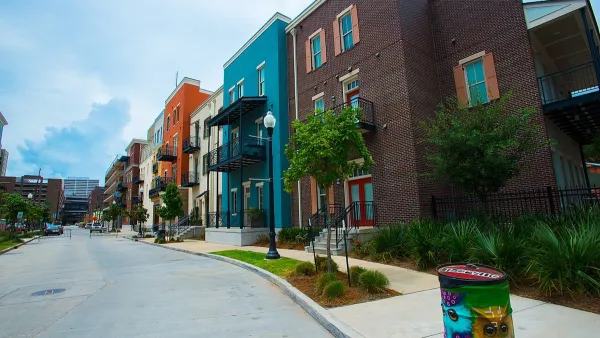It’s time to rewrite California’s building and planning codes for the 21st century, says architect Mark Hogan.

California's obstacles to addressing climate change and the housing shortage include its own code, a piece in BOOM argues.
Layers of code create what Hogan calls a "hairball"—a term borrowed from programming—in which, ultimately, "each bit of code can be used to stop another from doing its work." He writes:
Some of California’s own largest policy initiatives are at odds with each other … Reducing VMT requires density, but density is nearly impossible to achieve while constructing net-zero buildings.
To tease out some of the threads making up the hairball of code, Hogan tackles the history of planning, zoning, and building codes across California since the late 19th century. Though they generally arose independently in each city, early codes were defined by the times: they sought to counter the conditions of early American cities through ample space, separation from industry, and, of course, racist exclusion.
Though planning goals have changed, in many cases, codes have not kept up. Now, Hogan urges, "[in order to] create affordable cities, responsive to a changing climate and prudent with limited natural resources, we may need to rewrite the rules from scratch with a new set of goals in mind."
For one, he suggests semi-dense urban development—think low-rise apartments or in-law units:
Disallowing this kind of gentle medium density in the name of preserving neighborhood character does a disservice to those who arrived here or were born too late to afford a single-family home within commuting distance of their jobs. It also fails to recognize that making communities more walkable and sustainable will improve neighborhood character over time, not diminish it.
FULL STORY: Re-Coding Planning

National Parks Layoffs Will Cause Communities to Lose Billions
Thousands of essential park workers were laid off this week, just before the busy spring break season.

Retro-silient?: America’s First “Eco-burb,” The Woodlands Turns 50
A master-planned community north of Houston offers lessons on green infrastructure and resilient design, but falls short of its founder’s lofty affordability and walkability goals.

Delivering for America Plan Will Downgrade Mail Service in at Least 49.5 Percent of Zip Codes
Republican and Democrat lawmakers criticize the plan for its disproportionate negative impact on rural communities.

Test News Post 1
This is a summary

Test News Headline 46
Test for the image on the front page.

Balancing Bombs and Butterflies: How the National Guard Protects a Rare Species
The National Guard at Fort Indiantown Gap uses GIS technology and land management strategies to balance military training with conservation efforts, ensuring the survival of the rare eastern regal fritillary butterfly.
Urban Design for Planners 1: Software Tools
This six-course series explores essential urban design concepts using open source software and equips planners with the tools they need to participate fully in the urban design process.
Planning for Universal Design
Learn the tools for implementing Universal Design in planning regulations.
EMC Planning Group, Inc.
Planetizen
Planetizen
Mpact (formerly Rail~Volution)
Great Falls Development Authority, Inc.
HUDs Office of Policy Development and Research
NYU Wagner Graduate School of Public Service





























